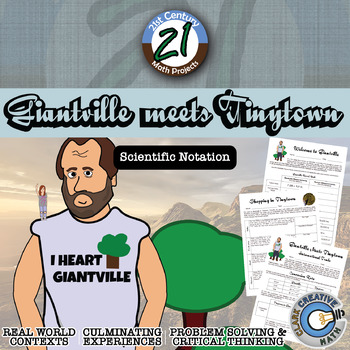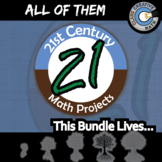Giantville Meets Tinytown -- Scientific Notation - 21st Century Math Project
- Zip
- Google Apps™

What educators are saying
Also included in
- The project is the core of what I have built my classroom around. Scaffolding learners to real world projects. This bundle includes the 105+ math projects I have written. This is over 2,700 pages of content.21st Century Math Projects each scaffold through an authentic context and math skill buildingPrice $395.00Original Price $564.00Save $169.00
- This is a selection of my Scientific Notation resources all in a money saving Essential Bundle! You save significant money and time versus purchasing these separately!Essential Bundles are designed to give you everything you need to rock your unit. Warmups, Notes, Activities, Games, Exit Tickets, anPrice $25.00Original Price $60.00Save $35.00
Description
If you've ever felt like you were in fantasy land when you've taught scientific notation, you are not alone. In this whimsical 21st Century Math Project, a human will journey to two fictional cities Giantville (where all the numbers are enormous) and Tinytown (where all the numbers are microscopic). Help the human navigate through the cities and even arrange trade between them!
In this 16 page document you will be given a mapping to the Content Standards and three assignments. ***THIS PRODUCT HAS BEEN UPDATED WITH A GOOGLE SLIDES INTERACTIVE VERSION INCLUDED. REDOWNLOAD IF YOU HAVE IT ALREADY***
Included are:
-- In “Welcome to Giantville” and “Tinytown Welcomes You” students become acquainted with translating between scientific to standard notation.
-- In “Shopping in Giantville” and “Shopping in Tinytown” students practice basic operations with scientific notation.
-- In “Giantville Meets Tinytown: International Trade” students brainstorm a solution for converting between the currencies of the two countries. Students will then use these conversions to complete order forms for exports from each of the countries. This will be an opportunity for students to explore developing an algorithm.
An answer key has been added to the end of the file for your convenience.
You may be interested in the following discounted bundles. SAVE $$$!
•Exponents, Roots & Scientific Notation
•21st Century Math Projects -- All the Projects
Need an Entire Curriculum?
•21st Century Pre-Algebra –- the Entire Curriculum
•21st Century Algebra –- the Entire Curriculum
For more tips, tricks and ideas check out the Clark Creative Education Blog
And join our community where I post ideas, anecdotes, elaborations & every once in a while I pass out TPT gift cards! And jokes! I do jokes too!







